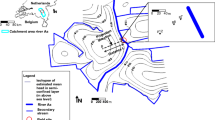Abstract
Rainfall is a major source for groundwater recharge. The response of groundwater level to rainfall is divided into quick and slow parts. This article presents a method to analyze the rainfall-induced quick groundwater-level (QGL) response. In the method, a technique of recursive digital filter was applied to splitting the rainfall-induced QGL response from a residual groundwater hydrograph in which the effects of both earth tide and barometric pressure were removed. The response of QGL to rain was simplified as a linear function and described by using a convolution of a rainfall sequence and a discrete Kernel function. Based on data of rainfall and corresponding QGL variations, the discrete Kernel function was determined via a linear system analysis. The method was applied to determining the discrete Kernel function and simulating the variation of QGL to rain at the station of Naba well in southwestern Taiwan. Comparison between the results of simulations and measurements of QGL variations shows that our proposed method can simulate the QGL response to rain with a value of root mean square error less than 4.26 mm. Based on the discrete Kernel function, an empirical, continue Kernel function was also proposed.








Similar content being viewed by others

References
Akaike H (1974) A new look at the statistical model identification. IEEE Trans Autom Control AC-19:716–723
Akaike H (1980) Likelihood and Bayes Procedure. In: Bayesian statistics. University Press, Valencia, pp 143–166
Arnold JG, Allen PM, Muttiah R, Bernhardt G (1995) Automated base flow separation and recession analysis technique. Ground Water 33(6):1010–1018
Bardsley WE, Campbell DI (2000) Natural geological weighing lysimeters: calibration tools for satellite and ground surface gravity monitoring of subsurface water-mass change. Nat Resour Res 9(2):147–156
Bronstert A, Plate E (1997) Modelling of runoff generation and soil moisture dynamics for hillslopes and micro-catchments. J Hydrol 198(1–4):177–195
Brutsaert W, Lopez JP (1998) Basin-scale geohydrologic drought flow features of riparian aquifers in the southern Great Plains. Water Resour Res 34(2):233–240
Corominas J, Moya J, Ledesma A, Rius J, Gili JA, Lloret A (1999) Monitoring of the Vallcebre landslide, Eastern Pyrenees, Spain. In: Proceedings of the International Symposium on Slope Stability Engineering, Matsuyama, Shikoku, pp 1239–1244
Dierks O, Neumeyer J (2002) Comparison of earth tides analysis programs. Marées Terr Bull d’informations 135:10669–10688
DPRC (2003) The study of groundwater anomalies associated with the earthquake (3/5). A Report to Water Resources Agency in Taiwan by Disaster Prevention Research Center (DPRC), National Cheng Kung University (in Chinese)
Dreiss SJ (1989) Regional scale transport in a Karst aquifer: 2 linear systems and time moment analysis. Water Resour Res 25(1):126–134
Furey PR, Gupta VK (2001) A physically based filter for separating base flow from streamflow time series. Water Resour Res 37(11):2709–2722
Igarashi G, Wakita H (1991) Tidal responses and earthquake-related changes in the water level of deep wells. J Geophys Res 96:4269–4278
Ishiguro M, Tamura Y (1985) BAYTAP-G in TIMSAC-84. Computer Science Monographs 22, Institute of Statistical Mathematics, pp 56–117
Jan CD, Chen TH, Lo WC (2007) Effect of rainfall intensity and distribution on groundwater level fluctuations. J Hydrol 332(3–4):348–360
Johnson CD (1987) Preferred water flow and localized recharge in a variable regolith. J Hydrol 94(1–2):129–142
Kormylo JJ, Jain VK (1974) Two-pass recursive filter with zero phase shift. IEEE Trans Acoust Speech Signal Process 22(5):384–387
Lyne VD (1979) Recursive modeling of sluggish and time-varying streamflow responses. M. Eng. Sc. Thesis, University of Western Australia, Department of Civil Engineering
Lyne V, Hollick M (1979) Stochastic time-variable rainfall-runoff modelling. In: Hydrology and water resources symposium, the national committee on hydrology and water resources of the institution of engineers, Perth, pp 89–92
Lynn PA (1973) An introduction to the analysis and processing of signals, 3rd edn. Macmillan Education Ltd, London
Matsumoto N (1992) Regression analysis for anomalous changes of ground water level due to earthquakes. Geophys Res Lett 19(12):1193–1196
Nathan RJ, McMahon TA (1990) Evaluation of automated technique for base flow and recession analyses. Water Resour Res 26(7):1465–1473
Panapitukkul N, Pengnoo A, Siriwong C, Chatupote W (2005) Hydrogeomorphological controls on groundwater quality in the Rattaphum catchment (Songkhla Lake Basin), Thailand. Water Air Soil Pollut Focus 5(1–2):149–163
Quilty EG, Roeloffs EA (1991) Removal of barometric pressure response from water level data. J Geophys Res 96:10209–10218
Rojstaczer S (1988) Determination of fluid flow properties from the response of water levels in wells to barometric loading. Water Resour Res 24:1927–1938
Seo HH (2001) Modeling the influence of changes in barometric pressure on groundwater levels in wells. Environ Geol 41:155–166
Simmers I (1988) Estimation of natural groundwater recharge. North Atlantic Treaty Organization. Scientific Affairs, p 498
Tamura Y, Sato T, Ooe M, Ishiguro M (1991) A procedure for tidal analysis with a Bayesian information criterion. Geophys J Int 104(3):507–516
Wittenberg H, Sivapalan M (1999) Watershed groundwater balance estimation using streamflow recession analysis and baseflow separation. J Hydrol 219(1–2):20–33
Acknowledgments
The research was partially supported by the National Science Council (NSC 99-2625-M-006-002) and the Water Resources Agency in Taiwan.
Author information
Authors and Affiliations
Corresponding author
Rights and permissions
About this article
Cite this article
Jan, CD., Chen, TH. & Huang, HM. Analysis of rainfall-induced quick groundwater-level response by using a Kernel function. Paddy Water Environ 11, 135–144 (2013). https://doi.org/10.1007/s10333-011-0299-6
Received:
Revised:
Accepted:
Published:
Issue Date:
DOI: https://doi.org/10.1007/s10333-011-0299-6



